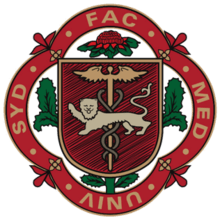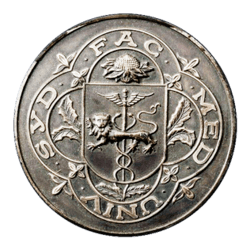Sydney Medical School
 | |
| Type | Public |
|---|---|
| Established | 1856 |
Parent institution | University of Sydney |
| Dean | Professor Arthur Conigrave (Acting) |
| Location | Sydney, New South Wales, Australia |
| Campus | Urban |
| Website | sydney.edu.au/medicine |

Sydney Medical School (SMS) is the graduate medical school of the University of Sydney. Established in 1856, it is the first medical school in Australia.[1][2] In 2017, SMS was ranked by QS World University Rankings as the top medical school in Australia and among the top 15 on an international level.[3]
The School has a large and diverse faculty[4] to support its missions in education, research, and health care. Each year, it has over 1,100 medical students and 2,000 postgraduate students undertaking coursework and research-training programs.[5]
History
Sydney Medical School was established in 1856 as The University of Sydney Faculty of Medicine by a group of University of Edinburgh Medical School graduates, Thomas Peter Anderson Stuart, Charles Nicholson and Alexander McCormick.
Sydney Medical Program
Sydney Medical School offers a four-year graduate medical program. Key course features include a hybrid problem-based learning model, early clinical exposure, online learning resources, and a focus on evidence-based medicine, which were modelled on aspects of the New Pathway Doctor of Medicine (MD) program at Harvard Medical School.[6] The curriculum has won numerous teaching awards and is licensed to universities in the UK, South Africa and the Middle East and to other universities in Australia.[7]
First introduced in 1997, the graduate medical program originally led to the degrees of Bachelor of Medicine and Bachelor of Surgery (MBBS) for historical reasons. Since 2014, the MD has replaced the MBBS as the title of the medical degree conferred by the Sydney Medical Program.[8]
Entry into the Sydney Medical Program is on the basis of a satisfactory grade point average, the Graduate Australian Medical School Admissions Test score, and performance in a multiple mini-interview. Each year's cohort has approximately 300 students enrolled, an appreciable proportion of which are international students.[9]
Undergraduate provisional entry
The School also offers an undergraduate-entry, "combined medicine" pathway, in which a provisional place is held in the Sydney Medical Program for students until they complete one of the following three-year undergraduate degrees at the University:
- Bachelor of Commerce
- Bachelor of Economics
- Bachelor of Medical Science
- Bachelor of Music Studies
- Bachelor of Science (Advanced)
Securing such a place is highly competitive, as only ten to thirty such places are offered each year. Entry is on the basis of the Australian Tertiary Admission Rank (ATAR) or equivalent, and a semi-structured panel interview. For Music Studies-Medicine only, an additional audition at the Sydney Conservatorium of Music is required.
Since the introduction of this admissions pathway in 2005,[10][11] the ATAR cut-off or equivalent has consistently been 99.95 (except for Music Studies-Medicine, which has been 99.50).[10][12][13][14][15] the highest cut-off of any undergraduate-entry program offered in Australia.[16][17]
Research activity
The School has a very large research base, with its disciplines and affiliated institutes actively engaged in research in both the basic sciences and all major areas of clinical medicine, through six major themes:[18]
- Cancer
- Chronic Disease and Ageing
- Infection and Immunological Conditions
- Neurosciences and Mental Health
- Obesity, Diabetes and Cardiovascular Disease
- Reproductive, Maternal and Child Health
Clinical schools and teaching hospitals
Sydney Medical School is supported by eight clinical schools, which are based at major teaching hospitals across New South Wales:[5]
- Central Clinical School: Royal Prince Alfred Hospital
- Westmead Clinical School: Westmead Hospital
- The Children's Hospital at Westmead Clinical School: Royal Alexandra Hospital for Children
- Concord Clinical School: Concord Repatriation General Hospital
- Nepean Clinical School: Nepean Hospital
- Northern Clinical School: Royal North Shore Hospital
- School of Rural Health: Dubbo Base Hospital and Orange Base Hospital
- Sydney Adventist (SAN) Clinical School: Sydney Adventist Hospital
A number of smaller hospitals also act as teaching hospitals.
Notable alumni
- Dr Victor Chang AC - Pioneer of modern heart transplantation
- Dr George Henry Abbott – Surgeon and former Fellow University of Sydney
- Assoc Prof John Carter AO – Endocrinologist and former president Australian Diabetes Society
- Dr Alan Colwell – Former President Royal Australian and New Zealand College of Radiologists[19]
- Prof David A. Cooper AO - HIV/AIDS researcher
- Emeritus Prof James de Haseth – Emeritus Professor of Chemistry at the University of Georgia[20]
- Prof William Doe – Provost Aga Khan University and former Dean of Medicine University of Birmingham
- Dr Stanley Devenish Meares CBE – Former President Australian Council Royal College of Obstetricians and Gynaecologists
- Clinical Professor Greg Fulcher – Head of Research, Clinical Medicine, Kolling Institute of Medical Research[21]
- Prof Peter Green – Director of the Celiac Disease Center at Columbia University
- Dr Harry Critchley Hinder – Surgeon and Former President of the NSW Branch of the British Medical Association[22]
- Sir Keith Jones – Surgeon and Former President of the Australian Medical Association
- Sir Herbert Maitland – Surgeon
- Sir William Morrow DSO ED – Former President Royal Australasian College of Physicians
- Dr Cecil Purser – Former chairman Royal Prince Alfred Hospital
- Prof Nicholas Saunders AO – Former Vice-Chancellor University of Newcastle and former Dean of Medicine Monash University and Flinders University
- Prof Martin Stockler – Professor of Oncology and Clinical Epidemiology University of Sydney Medical School[23]
- Dr Frank Tidswell – Former Director New South Wales Government Bureau of Microbiology and Director of Pathology at the Royal Alexandra Hospital for Children
- Emeritus Prof John Turtle AO – Former Kellion Professor of Endocrinology University of Sydney, Co-Founder Australian Diabetes Society and Former president International Diabetes Federation
- Prof Donald Wood-Smith – Professor of Clinical Surgery Columbia University New York
- Dame Marie Bashir – Former Governor of New South Wales
- Philip Nitschke – Physician, humanist, author, founder and director of the pro-euthanasia group Exit International
- Sir Gustav Nossal – Immunologist
- Graeme Clark – Key figure in the development of bionic ear
- John Diamond – Physician and author on holistic health and creativity
- Gerald M. Lawrie – Heart surgeon and pioneer in the surgical treatment of valvular heart disease
- Wirginia Maixner – Neurosurgeon
- Harry Windsor – Heart surgeon
- Rachael Dunlop – Medical researcher and sceptic
- Dave Sharma – Australian diplomat
- Brian Owler – President of the Australian Medical Association
- Sydney James Van Pelt – Pioneer of modern hypnotherapy
- Charles George McDonald – Physician, army officer and academic
- Susie O'Reilly – Family doctor and obstetrician, noted for her rejected application for residency at Sydney Hospital in favour of male applicants in 1905 despite her excellent academic record
References
- ↑ "Charles Nicholson". Retrieved 15 January 2014.
- ↑ "Country's oldest medical school". University of Sydney. Retrieved 2011-06-07.
- ↑ "QS World University Rankings by Subject 2017 - Medicine". QS World University Rankings. Retrieved 2017-04-18.
- ↑ "Featured academics". University of Sydney. Archived from the original on 2012-11-02. Retrieved 2011-06-11.
- 1 2 "Sydney Medical School Prospectus" (PDF). University of Sydney. March 2011. Retrieved 2011-06-11.
- ↑ "Sefton, Ann Elizabeth Jervie - Sydney Medical School Online Museum and Archive". University of Sydney. Retrieved 2011-06-11.
- ↑ "Information for future students". University of Sydney. Retrieved 2011-06-11.
- ↑ "University of Sydney announces new Doctor of Medicine - MD program". University of Sydney. Retrieved 2013-09-20.
- ↑ "Medical student demographics". University of Sydney. Retrieved 2011-06-08.
- 1 2 "Admission Policy Review" (PDF). University of Sydney. 2009-03-13. Retrieved 2011-06-11.
- ↑ "A new elite course attracts the cream of school leavers" (PDF). University of Sydney. April 2005. Retrieved 2011-06-11.
- ↑ "Academic Board Course Proposal for Commerce–Medicine and Economics–Medicine" (PDF). University of Sydney. 2008-04-02.
- ↑ "Admission to Science–Medicine". University of Sydney. Archived from the original on 2006-03-14. Retrieved 2011-06-11.
- ↑ "Your Guide to Medicine at Sydney Medical School 2012" (PDF). University of Sydney. Retrieved 2011-06-07.
- ↑ "ATAR for the Combined Medicine Program". University of Sydney. Retrieved 2011-06-07.
- ↑ "Academic Board Phase Three Review" (PDF). University of Sydney. June 2008. Retrieved 2011-06-11.
- ↑ "All About our ATAR" (PDF). Universities Admissions Centre. Retrieved 2011-06-07.
- ↑ "Radius March 2012" (PDF). University of Sydney. Retrieved 2012-10-07.
- ↑ "Radiologists Elect Officers.". The Mercury (Hobart, Tas. : 1860 – 1954). Hobart, Tas.: National Library of Australia. 21 November 1953. p. 6. Retrieved 5 February 2013.
- ↑ Staff – James de Haseth Retrieved 12 August 2012
- ↑ University of Sydney – Greg Fulcher Retrieved 4 July 2013
- ↑ Harry Critchley Hinder Retrieved 8 December 2013.
- ↑ Martin Stockler Sydney Medical School Retrieved 22 June 2013
